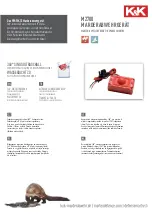
29
STAC5 Hardware manual
920-0026 Rev. B
4/22/2011
Motor Heating
Step motors convert electrical power from the driver into mechanical power to move a load. Because step motors are not perfectly effi-
cient, some of the electrical power turns into heat on its way through the motor. This heating is not so much dependent on the load being
driven but rather the motor speed and power supply voltage. There are certain combinations of speed and voltage at which a motor cannot
be continuously operated without damage.
We have characterized the recommended motors in our lab and provided curves showing the maximum duty cycle versus speed for each
motor and drive. Please refer to these curves when planning your application.
Please also keep in mind that a step motor typically reaches maximum temperature after 30 to 45 minutes of operation. If you run the
motor for one minute then let it sit idle for one minute, that is a 50% duty cycle. Five minutes on and five minutes off is also 50% duty.
However, one hour on and one hour off has the effect of 100% duty because during the first hour the motor will reach full (and possibly
excessive) temperature.
The actual temperature of the motor depends on how much heat is conducted, convected or radiated out of it. Our measurements were
made in a 40°C (104°F) environment with the motor mounted to an aluminum plate sized to provide a surface area consistent with the
motor power dissipation. Your results may vary.
120
Duty Cycle HT23-552
100
80
e
%
60
Duty
Cy
cl
e
20
40
0
0
5
10
15
20
25
30
35
40
45
50
0
5
10
15
20
25
30
35
40
45
50
Speed(RPS)
120
Duty Cycle HT23-553
100
80
e
%
60
Duty
Cy
cl
e
20
40
0
0
0
5
10
15
20
25
30
35
40
45
50
0
5
10
15
20
25
30
35
40
45
50
Speed(RPS)
120
Duty Cycle HT23-554
100
80
e
%
60
Duty
Cy
cl
e
20
40
0
0
0
5
10
15
20
25
30
35
40
45
50
0
5
10
15
20
25
30
35
40
45
50
Speed(RPS)
120
Duty Cycle HT34-495
100
80
e
%
60
Duty
Cy
cl
e
20
40
0
0
0
5
10
15
20
25
30
35
40
45
50
0
5
10
15
20
25
30
35
40
45
50
Speed(RPS)






































